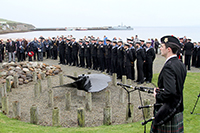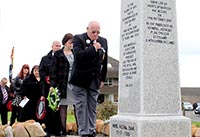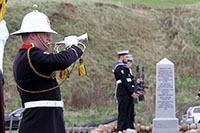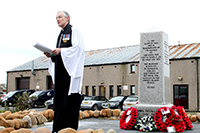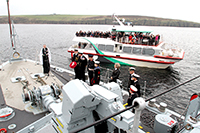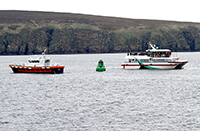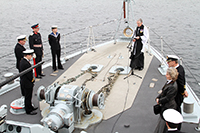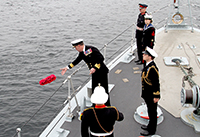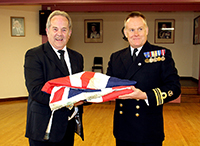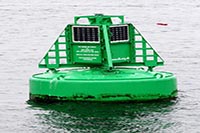Report by Andrew Hamilton
The Orcadian
www.orcadian.co.uk
Memorial events marking the 75th anniversary of the sinking of HMS Royal Oak in Scapa Flow took place this week. On Tuesday, on an overcast and sombre day, senior Royal Navy officers, members of HMS Bangor’s ship’s company, and personnel from Northern Diving Group, alongside guests and veterans, gathered to remember those who died in the early hours of October 14, 1939, when the Royal Oak was torpedoed by a German submarine, with devastating loss of life.
Built at a cost of £2.5 million, and launched in 1914, the 27,000 tonne Revenge-class battleship had been presumed unsinkable by submarine attack within Scapa Flow — however, this false sense of security was shattered when German U-boat commander Lt Günther Prien evaded the flimsy defences in the submarine U47, and attacked at the heart of the British Navy.
Of the ship’s complement of 1,234 men and boys, 834 were killed that night, or died later of their wounds.
The memorial events started at 9.30am, with a short service led by RNA chaplain David Dawson at the Garden of Remembrance at Scapa.
Laurence Tait, Kirkwall City Pipe Band Pipe Major, played Highland Cathedral, before a Royal Marine bugler sounded The Last Post.
Kirkwall Royal British Legion president Bryan Taylor then recited the poignant lines from Binyon’s For the Fallen:
“They shall grow not old, as we that are left grow old: Age shall not weary them, nor the years condemn. At the going down of the sun and in the morning We will remember them.”
After a two-minute silence, wreaths were then laid at the memorial, followed by the Reveille.
The parties then set out from Scapa pier on HMS Bangor and the Talisman launch Flotta Lass, to pay their respects and lay wreaths at the final resting place of the Royal Oak, which lies beneath the grey waters of Scapa Flow.
This year, the Royal Navy tributes were led by Rear Admiral John Clink.
The memorial service was the culmination of major Royal Navy activity in Orkney this week.
Last Thursday, HMS Bangor, a Sandown-Class minehunter, sailed into Kirkwall Harbour for a six-day visit.
Throughout the week, Navy representatives attended a service at St Magnus Cathedral, a presentation was held in the Orkney Theatre on Monday, and the Bangor opened her gangway to members of the public on Saturday and Sunday. Also, on Thursday, members of the Royal Navy’s Northern Diving Unit, based at HM Naval Base Clyde, near Glasgow, replaced the white ensign attached to the stern of the Royal Oak.
The divers also undertook their annual survey of the wreck to ensure the ship maintains a minimal impact on the important and sensitive environment of Scapa Flow.
The lead diver for the flag replacement was Petty Officer Alan Dickman, who was accompanied for the ceremony by the Northern Diving Group’s youngest member, Able Rate Alexander Briggs, 22.
PO Dickman is the Northern Diving Group’s longest serving member, and the HMS Royal Oak commitments this weekend were his final major project with the Royal Navy before retiring.
As in years past, the ensign was presented to a recipient chosen by Agnes Millar, area co-ordinator for the Royal Oak Survivors’ Association, and Bryan Taylor, at the Kirkwall branch of the Royal British Legion.
This year it was Henry Blyth who spoke of the “huge honour” he felt on receiving the ensign.
Mr Blyth’s uncle, also Henry Blyth, was lost, aged 23, when the Royal Oak went down at 1.30am on October 14, 1939.
Three years later to the day, also at 1.30am, Mr Blyth was born, and was accordingly named after his uncle.
He said: “For some reason, that always stuck with me as a youngster. It’s really, really moving to be able to attend such a service as this, and hopefully it will continue for the foreseeable future.”
On being chosen to receive the ensign, he added: “It’s amazing. I always had an interest in being considered for it, but there are obviously direct relatives — sons who have lost fathers — so me being a nephew, I thought I might have to wait some time.
“I was over the moon when Bryan and Agnes phoned me to ask if I’d be willing to accept the ensign. No matter what else you get in life, this is just a huge honour to be presented with the ensign.”
Mr Blyth, who was celebrating his 72nd birthday, and whose son Gavin had travelled from Australia to attend the commemorations, previously donated a plaque made on board the Royal Oak by his uncle, which is now on display at the Scapa Flow Visitor Centre at Lyness.
Tom Muir, from the Orkney Museum, took the plaque to the Legion on Tuesday for the commemoration events.
“My uncle made the plaque out of gunmetal. The design was his as he was a painter and decorator by trade,” Mr Blyth said.
“On his last home visit, he gave it to his mum and dad, my grandmother and grandad, who gave it to my dad, who then passed it on to me.
“It had been in my garage for a few years but, after visiting Orkney for the 70th anniversary events, and having been two or three times before that, I decided that Orkney was the place it should be.”
Mr Blyth, who lives in Leven, Fife, went on to say that he plans to donate the ensign to his local parish church, where it will be displayed alongside a photograph and information on the HMS Royal Oak.
Naval Regional Commander Scotland and Northern Ireland Captain Chris Smith said “It’s very important for the RN to support commemorative events such as this.
“The Northern Diving Group has done so for years, and this year, to mark the 75th anniversary, we’ve managed to bring a ship to the Northern Isles and embark veterans and members of the local community so that they may pay their respects at the actual site of the wreck.
“It’s impressive that so many people have made such an effort, some travelling the length of the country and even from abroad to be here.
“It’s quite humbling, and of course quite significant in this, the 100th anniversary of the First World War, because Royal Oak was a veteran of that war, taking part in the Battle of Jutland before ultimately becoming an early casualty of the Second World War.
“Orkney is a seafaring community, and the history of Scapa sits very close to the surface here, so I’m very happy and indeed honoured, that we’ve been able to play a part in acknowledging the historic and continued importance of this part of the UK to the Royal Navy and its role in both World Wars.”
by Andrew Hamilton
The Orcadian
Click on images for a larger version in a new window
Copies of these and many more photos of the event are available at
